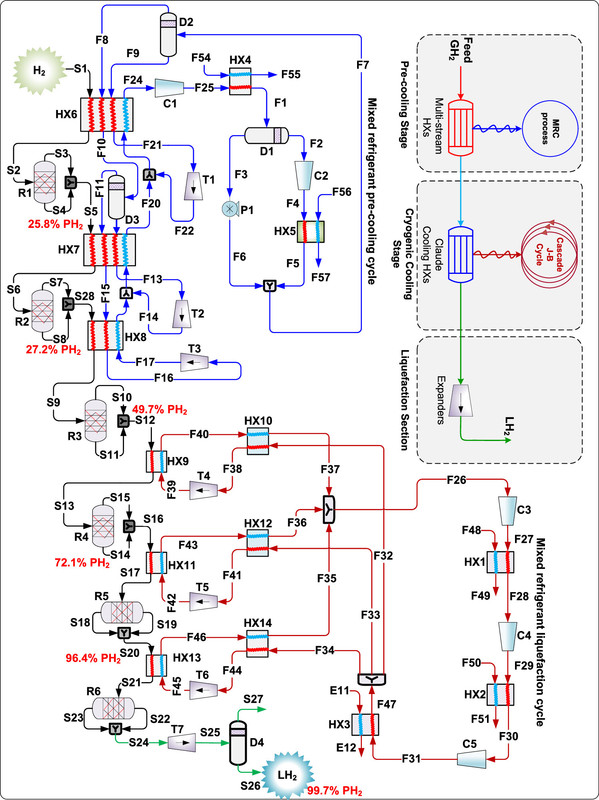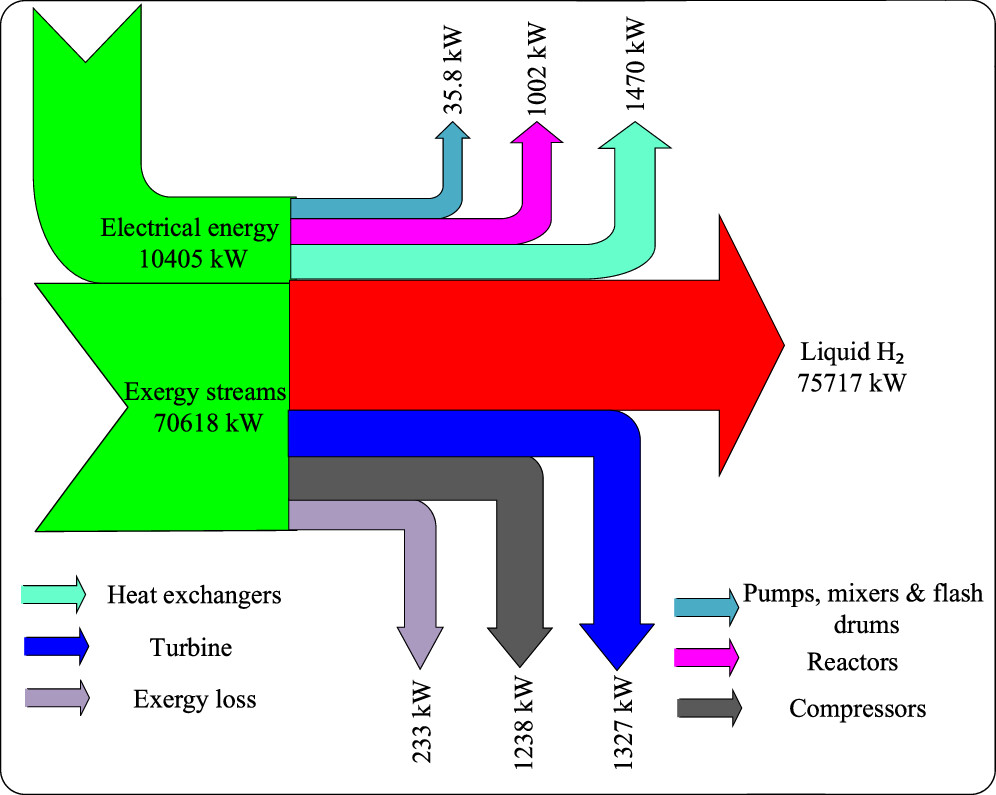Environment & Energy
Related: About this forumEconomic and environmental costs of liquifying hydrogen.
The paper to which I'll refer in this post is this one: Efficient Design of the Hydrogen Liquefaction System: Thermodynamic, Economic, Environmental, and Uncertainty Perspectives Bahram Ghorbani, Sohrab Zendehboudi, Zahra Alizadeh Afrouzi, Ali Lohi, and Faisal Khan Industrial & Engineering Chemistry Research 2024 63 (33), 14668-14699.
It is a very long paper, with some very interesting points, including some of which I was unaware, for instance the exothermic change in the quantum states as hydrogen is cooled from parallel to nonparallel spin states. (See below.) There's a lot of mathematics, not overly complex, summations mainly, and many interesting process diagrams, a few of which I'll post. However I won't have a lot of time to go into deep detail on this paper, which to my mind, shows exactly how stupid, dangerous, and wasteful this widely held belief that hydrogen is "green" actually is. I will briefly excerpt it, and produce a few graphics from it to demonstrate that not only is exergy destroyed with respect to the fossil fuels from which hydrogen is overwhelmingly manufactured, but even more exergy is destroyed merely by liquifying it for the storage.
(I can't believe I have to make the italicized statement, but apparently I do, because recently I was confronted with the true statement that exergy is destroyed in all thermodynamic processes, as if this somehow justified destroying a greater amount of exergy for the idiotic faith in the hydrogen game. One hears these sort of things and doesn't want to believe it.)
The width of this belief, that hydrogen is "green," or (slightly less dishonest) will be "green," by the way, is broad, and includes many serious people, some better educated than others, some more or less honest than others, and here and elsewhere, there are intellectually weak and logically insupportable rhetoric such as "appeal to authority" arguments or "bandwagon fallacy" arguments, none of which are solid.
I have been rather tireless in stating that in my opinion, much like the nonstarter of CO2 "sequestration," so called "renewable energy" and other unworkable well advertised ploys to greenwash fossil fuels, "green" hydrogen nothing more than a dishonest marketing ploy by the vested interests in doing nothing serious to undo, to any extent possible, if there is such an extent, the extreme global heating we are now experiencing with all of its attendant disasters created by that status quo.
To my mind - and I remain and will remain unashamed of stating it - the status quo is a triumph of antinukism. The extreme global heating we are experiencing did not have to happen, but it did happen, and it did so as a result of poor choices made by directed selective attention.
The paper begins with statements implying that hydrogen as a consumer energy source is, or might be, a worthy exercise, with which I disagree emphatically, because the authors claim so called "renewable energy" is "compatible with the environment," which it isn't. It also refers, to a lack of "public trust" with respect to the only clean form of energy there is, nuclear energy. This lack of public trust is the result of advertising, and excludes the reality that in terms of environmental and health damage associated with nuclear energy, all other forms of energy are many orders of magnitude worse.
Anyway, here's that introduction devoid of my editorial comment:
The idea that so called "renewable energy" is hyped as an alternative to fossil fuels is only a very recent add on to this reactionary scheme to return to the 19th century and earlier for energy supplies. That was hardly the original intent of the reactionaries who pushed it. The main motivation for this scheme having risen in popularity, causing the expenditure of trillions of dollars and the destruction of vast stretches of wilderness is the other "reason" is that they are claimed (but not observed) to be a "promising alternative" to the only clean and scalable form of energy there is, nuclear energy. The cults behind this thinking have certainly succeeded in demonizing nuclear energy and the results are in: 2024 is shaping up to be the worst year ever for new accumulations of the dangerous fossil fuel waste carbon dioxide in the planetary atmosphere, which I've been following very closely, and have been following closely for decades.
Latest Update on the Disastrous 2024 CO2 Data Recorded at Mauna Loa
The authors continue with a description of how important the liquefaction of hydrogen would be if the fossil fuel industry succeeds in its unending half a century long quest to rebrand fossil fuels as "hydrogen."
The physical-based (i.e., compressed, liquid, and cryo-compressed), material-based (i.e., physical and chemical adsorption), and chemical-based (i.e., liquid organic H2 carriers, ammonia derivatives, methanol, and formic acid) techniques are introduced as the principal methods of H2 storage. (22−24) The underground gas storage, salt and rock caverns, emptied oil and gas reservoirs, and nonoperational underground mines are used for large-scale H2 storage. (25−27) Storing H2 in liquid form is recognized as a primary method for large-scale and high-purity H2 storage in the context of long-distance energy transfer. This strategy is essential for various applications, including the supply of H2 to remote industrial facilities, power plants, and fueling stations. However, high specific power consumption (SPC) for liquefaction, low exergy efficiency of systems, inevitable boil-off gas (BOG), and increasing greenhouse gas emissions to supply energy are considered as major problems. (28−33) There are several ways to improve the performance of the H2 liquefaction cycles. These methods include the use of absorption/ejector/mixed refrigeration cycles, (11,34−36) liquefied natural gas/liquid nitrogen regasification operations, (37−39) and liquid air cold energy recovery (40) to precooling of H2 liquefaction systems. Also, operational optimization of refrigeration cycles, (41−44) performance improvement by pinch analysis, (45−47) and the use of waste heat recovery in various industries can be implemented for precooling and liquefaction processes. The operational optimization methods to adjust the main design variables and pinch analysis to modify the network structure of heat exchangers are promising strategies to enhance the performance of H2 liquefaction configurations. Designing a systematic method based on pinch and multiobjective optimization (MOO) techniques is necessary to optimize thermodynamic, economic, and environmental aspects.
They list the problems, and possible means to make the energy and environmental cost lower but they do not eliminate the costs, nor do they really go into the deeper details of what the expense of building all these improved liquefaction plants might be. We are talking on a scale of billions of tons, not laboratory bench tops. (Because we are talking in billions of tons, it won't happen on any meaningful scale, but as is the case with so called "renewable energy" it might cost trillions of dollars to recognize this.)
Again, there's a lot of detail in this paper; it's deep and interesting, even if it is service of trying to evaluate the unacceptable as though it might be rendered acceptable. Let's just check out some brief additional text and then look at some graphics which tell the story well enough.
The process description utilized in the paper for "improved liquefaction:
Note that there is a description of power not energy, "10,405 kW" as if the plant could operate continuously to produce 50 tons of liquid hydrogen per day, this in a theoretical world where energy is produced by so called "renewable energy." However, the problem is that so called "renewable energy" is not reliable, and thus if the purpose of the liquid hydrogen is to store the "renewable energy" to address its unreliability, hydrogen will have to be burned to run the plant continuously. There is some clearly circular reasoning here. There is an "LCA" "life cycle analysis" portion of the paper which reports units of kg CO2/kg H2 (see below)
Some graphics from the paper:
The (elaborate) process diagram:

The caption:
The modeling algorithm the authors employ to improve the liquefaction process:

The caption:
Exergy analysis of the liquefaction process, which is beyond the exergy destruction of manufacturing the hydrogen, which the authors presumably glibly assume, despite its 2024 triviality, will come from the magic "renewable energy" "transition" that did not come, is not here, and won't come.

The caption:
The paper to which I'll refer in this post is this one: Efficient Design of the Hydrogen Liquefaction System: Thermodynamic, Economic, Environmental, and Uncertainty Perspectives Bahram Ghorbani, Sohrab Zendehboudi, Zahra Alizadeh Afrouzi, Ali Lohi, and Faisal Khan Industrial & Engineering Chemistry Research 2024 63 (33), 14668-14699.
It is a very long paper, with some very interesting points, including some of which I was unaware, for instance the exothermic change in the quantum states as hydrogen is cooled from parallel to nonparallel spin states. (See below.) There's a lot of mathematics, not overly complex, summations mainly, and many interesting process diagrams, a few of which I'll post. However I won't have a lot of time to go into deep detail on this paper, which to my mind, shows exactly how stupid, dangerous, and wasteful this widely held belief that hydrogen is "green" actually is. I will briefly excerpt it, and produce a few graphics from it to demonstrate that not only is exergy destroyed with respect to the fossil fuels from which hydrogen is overwhelmingly manufactured, but even more exergy is destroyed merely by liquifying it for the storage.
(I can't believe I have to make the italicized statement, but apparently I do, because recently I was confronted with the true statement that exergy is destroyed in all thermodynamic processes, as if this somehow justified destroying a greater amount of exergy for the idiotic faith in the hydrogen game. One hears these sort of things and doesn't want to believe it.)
The width of this belief, that hydrogen is "green," or (slightly less dishonest) will be "green," by the way, is broad, and includes many serious people, some better educated than others, some more or less honest than others, and here and elsewhere, there are intellectually weak and logically insupportable rhetoric such as "appeal to authority" arguments or "bandwagon fallacy" arguments, none of which are solid.
I have been rather tireless in stating that in my opinion, much like the nonstarter of CO2 "sequestration," so called "renewable energy" and other unworkable well advertised ploys to greenwash fossil fuels, "green" hydrogen nothing more than a dishonest marketing ploy by the vested interests in doing nothing serious to undo, to any extent possible, if there is such an extent, the extreme global heating we are now experiencing with all of its attendant disasters created by that status quo.
To my mind - and I remain and will remain unashamed of stating it - the status quo is a triumph of antinukism. The extreme global heating we are experiencing did not have to happen, but it did happen, and it did so as a result of poor choices made by directed selective attention.
The paper begins with statements implying that hydrogen as a consumer energy source is, or might be, a worthy exercise, with which I disagree emphatically, because the authors claim so called "renewable energy" is "compatible with the environment," which it isn't. It also refers, to a lack of "public trust" with respect to the only clean form of energy there is, nuclear energy. This lack of public trust is the result of advertising, and excludes the reality that in terms of environmental and health damage associated with nuclear energy, all other forms of energy are many orders of magnitude worse.
Anyway, here's that introduction devoid of my editorial comment:
The idea that so called "renewable energy" is hyped as an alternative to fossil fuels is only a very recent add on to this reactionary scheme to return to the 19th century and earlier for energy supplies. That was hardly the original intent of the reactionaries who pushed it. The main motivation for this scheme having risen in popularity, causing the expenditure of trillions of dollars and the destruction of vast stretches of wilderness is the other "reason" is that they are claimed (but not observed) to be a "promising alternative" to the only clean and scalable form of energy there is, nuclear energy. The cults behind this thinking have certainly succeeded in demonizing nuclear energy and the results are in: 2024 is shaping up to be the worst year ever for new accumulations of the dangerous fossil fuel waste carbon dioxide in the planetary atmosphere, which I've been following very closely, and have been following closely for decades.
Latest Update on the Disastrous 2024 CO2 Data Recorded at Mauna Loa
The authors continue with a description of how important the liquefaction of hydrogen would be if the fossil fuel industry succeeds in its unending half a century long quest to rebrand fossil fuels as "hydrogen."
The physical-based (i.e., compressed, liquid, and cryo-compressed), material-based (i.e., physical and chemical adsorption), and chemical-based (i.e., liquid organic H2 carriers, ammonia derivatives, methanol, and formic acid) techniques are introduced as the principal methods of H2 storage. (22−24) The underground gas storage, salt and rock caverns, emptied oil and gas reservoirs, and nonoperational underground mines are used for large-scale H2 storage. (25−27) Storing H2 in liquid form is recognized as a primary method for large-scale and high-purity H2 storage in the context of long-distance energy transfer. This strategy is essential for various applications, including the supply of H2 to remote industrial facilities, power plants, and fueling stations. However, high specific power consumption (SPC) for liquefaction, low exergy efficiency of systems, inevitable boil-off gas (BOG), and increasing greenhouse gas emissions to supply energy are considered as major problems. (28−33) There are several ways to improve the performance of the H2 liquefaction cycles. These methods include the use of absorption/ejector/mixed refrigeration cycles, (11,34−36) liquefied natural gas/liquid nitrogen regasification operations, (37−39) and liquid air cold energy recovery (40) to precooling of H2 liquefaction systems. Also, operational optimization of refrigeration cycles, (41−44) performance improvement by pinch analysis, (45−47) and the use of waste heat recovery in various industries can be implemented for precooling and liquefaction processes. The operational optimization methods to adjust the main design variables and pinch analysis to modify the network structure of heat exchangers are promising strategies to enhance the performance of H2 liquefaction configurations. Designing a systematic method based on pinch and multiobjective optimization (MOO) techniques is necessary to optimize thermodynamic, economic, and environmental aspects.
They list the problems, and possible means to make the energy and environmental cost lower but they do not eliminate the costs, nor do they really go into the deeper details of what the expense of building all these improved liquefaction plants might be. We are talking on a scale of billions of tons, not laboratory bench tops. (Because we are talking in billions of tons, it won't happen on any meaningful scale, but as is the case with so called "renewable energy" it might cost trillions of dollars to recognize this.)
Again, there's a lot of detail in this paper; it's deep and interesting, even if it is service of trying to evaluate the unacceptable as though it might be rendered acceptable. Let's just check out some brief additional text and then look at some graphics which tell the story well enough.
The process description utilized in the paper for "improved liquefaction:
Note that there is a description of power not energy, "10,405 kW" as if the plant could operate continuously to produce 50 tons of liquid hydrogen per day, this in a theoretical world where energy is produced by so called "renewable energy." However, the problem is that so called "renewable energy" is not reliable, and thus if the purpose of the liquid hydrogen is to store the "renewable energy" to address its unreliability, hydrogen will have to be burned to run the plant continuously. There is some clearly circular reasoning here. There is an "LCA" "life cycle analysis" portion of the paper which reports units of kg CO2/kg H2 (see below)
Some graphics from the paper:
The (elaborate) process diagram:

The caption:
The modeling algorithm the authors employ to improve the liquefaction process:

The caption:

The caption:
Here's a fun one, the cost of hydrogen based on current electricity prices, which presumably would be quite different in the alternative universe of the so called "renewable energy"/hydrogen paradise for which this liquefaction scheme is proposed

The caption:
And now for the really fun one, the LCA carbon cost per kg of liquefying hydrogen, beyond the cost of making it from dangerous fossil fuels:

The caption:
Now, if that 124 kg of CO2 per kg of H2 seems a little excessive - it certainly startled me when I first looked at the graphic, don't worry, be happy. That's only on day 1, the cost of the nasty refrigerants, all of which will be global warming potentiators. The following days are happy, happy, happy, happy. From the text:
By the way, the world is running out of helium, which is obtained by separation from natural gas obtained from some wells around the world. So there's that...
That's 3,185 tons of CO2 eq per ton, which leads one to wonder what a billion tons impact might be. A kg of liquid H2 is said to contain about 33 kWh/kg, in SI units, about 120 million joules. In 2022, according to the EIA, world energy demand was on the order of 632 Exajoules, this without the environmental cost of completely scrapping all the world's energy infrastructure in order to build plants to liquefy magic hydrogen. This suggests that for liquefaction alone, never mind the cost of tearing up vast stretches of wilderness to make industrial parks for wind and solar energy and hauling away them away every 20 to 25 years or so when they are rendered into landfill, would involve 5.3 billion tons of liquid hydrogen per year, leading to a carbon cost for "green" hydrogen, of 17 billion tons CO2eq. That's just to liquefy it, never mind shipping it and worse, making it.
For perspective, current emissions of CO2 is on the order of 36 billion tons per year recently, expected to rise significantly before the magic soothsaying of the EIA expects it to "peak" according to "scenarios."
Well this is just one paper, of course, I'm sure there are lots and lots and lots and lots of other papers that excite more magic. In fact, I know there are. I've been reading them for 50 years, on and off, while I waited for the world to start burning, which it is now so doing.
Anyway, the cool part of the paper in which I learned about the changes to the exothermic quantum spin states changing as hydrogen cools, another interesting thing along with the positive and unusual Joule Thomson effect of hydrogen. Because the DU editor doesn't really accommodate symbols well, it's posted as a graphic object.

Cool. Or hot. Or something.
I trust you've had a great weekend this far. Enjoy the evening.
Think. Again.
(17,907 posts)...storing and transporting energy without burning fossil fuels or emitting CO2.
But it's all meaningless unless we start actually building out a non-CO2 emitting energy industry to replace fossil fuels as quckly as possible.